If you like your horror with a heaping side of gory fun, Ryan Spindell is a filmmaker after your tell-tale heart. We sat down with Mr. Spindell to learn about the creation of his film The Root of the Problem (premiering on Short of the Week today) and the process of indie filmmaking in LA as a whole. We hope you find his words as insightful as we did:
Why does the horror genre appeal to you?
When we’re children it’s easy to believe in the fantastic. We feel things like fear, excitement and wonder on a deep, emotional level. As we grow up, we are assaulted by the real world and we lose touch with that part of ourselves. We stop believing in the things that go bump in the night. Horror has the power to make us feel that way again. To bring us back to a time when all things weird and wonderful seemed possible.
The horror genre is incredibly popular. It also can feel incredibly tired at times. How do you feel your approach to horror/sci-fi is different?
A problem with a lot of modern horror films is that the filmmakers are trying so hard to recreate the successes of the past that they forget to look to the future. Loving horror films is not the same as making horror films. As creators, it’s our job to push the medium forward in new and interesting ways and whether we succeed or fail, it’s important that we at least try.
I think it’s important to approach the horror genre in exactly the same way as you would any other genre. You start with strong characters and a great story and you build out from there.
On a personal level, I’ve always felt a kinship to the more “stylized” directors. Guys like Jean Pierre Jeunet, Peter Jackson and Terry Gilliam defined the way I look at cinema and it’s that quality of art and magic that I’m always striving to bring into my own work.
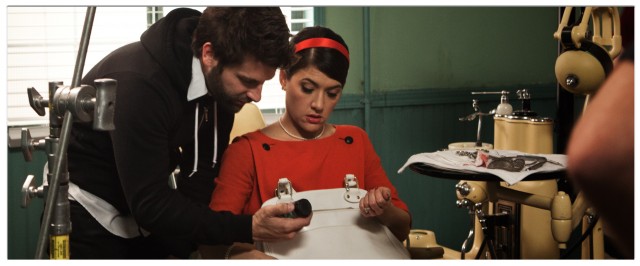
How did Root of the Problem come to life? Did it start with just a crazy idea (i.e. dentists are scary)? Or, does it stem from something else?
The concept of the film was born out of a narrative challenge. My co-writer Mark Davidson and myself wanted to see if we could tell a complete story in real-time with three characters and one tiny room.
The project started with a short script that Mark wrote about a woman losing her mind in a dentist office where the dentist may or may not have been a monster. I immediately fell in love with the quirky dentist character and although the script was set in modern day, I imagined him to be a 1950’s archetype snatched directly out of a Norman Rockwell painting. From there we developed it into a period piece and with that came the stylistic flourishes.
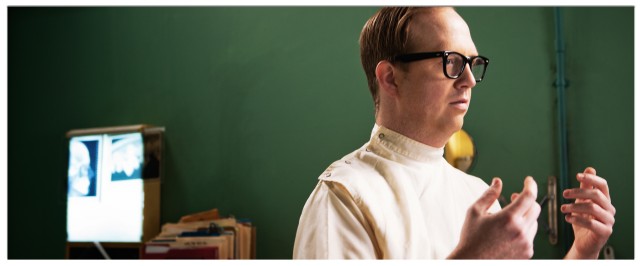
The final piece to the puzzle was understanding who the monsters were and what they wanted (if they are, in fact monsters). I did a bunch of research on the origins of the Tooth Fairy mythology hoping to find some dark and twisted nugget to use but came up empty handed. My only choice was to make up my own mythology, which turned out to be one of my favorite parts of the whole process.
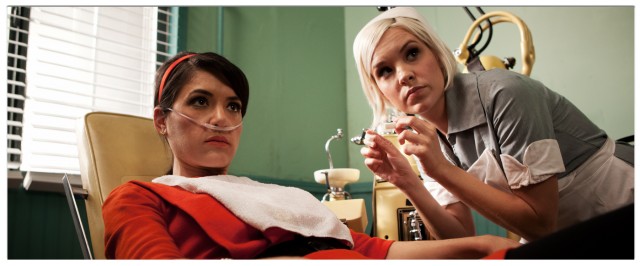
Is there a larger world you’re alluding to? Or, is this a film that’s just meant to stand on its own?
Oh yeah, there’s absolutely a larger story going on beyond the walls of this dentist office but it’s up to the audience to decipher the clues as to what that world is.
For deeper insight into the workings of the larger world, look no further than my other short films, all of which are set in the same universe. It’s my feeble way of being in control and I refuse to see a therapist about it!
The Root of the Problem has a phenomenal vintage aesthetic. How did you go about achieving that stellar look on our budget?
If you have the patience and determination, Craigslist can be a filmmaker’s best friend. While the budget was extremely limited, we had a good amount of time to prepare and I used that time to build almost everything from scratch.
Our biggest hurdle was finding a proper location that we could afford. After weeks of wrong turns and failed attempts, we decided to switch gears. If we couldn’t find a room, we would just build one. I immediately set to work searching Craigslist for used movie flats that people were throwing away and after a week or so, we were able to Frankenstein a set together from spare parts. It wasn’t much to look at, but you’d be surprised what a little paint and some molding can do.
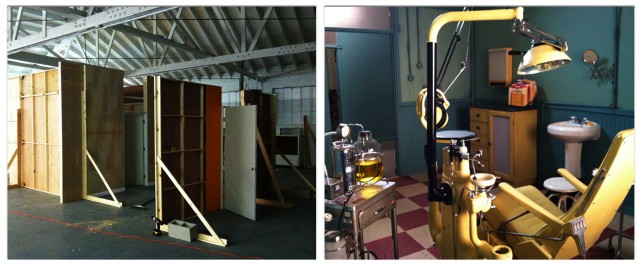
All the furnishings and set dressings were also purchased on Craigslist or at the Dollar Store and then painted and aged to match our aesthetic; the only exception being the anesthesia machine, which we rented from a local prop house.
Our grand total for everything you see on screen, including the set, came in right around $1,400.
How long did Root take to make (including pre-production and post)?
I’m a firm believer in the good / fast / cheap triangle. Which states that you only ever get two of the three and it’s your choice which. You can do it fast and cheap but it won’t be good, you can do it fast and good but it won’t be cheap, or you can do it cheap and good but it won’t be fast. For a project like this, with no real budget to speak of, our only option was good and cheap. In simpler terms – it took forever.
Our pre-production period was about four months, most of which I used securing and building all the set pieces and design elements. We saved a ton on design and that money went directly into production. We shot the film in my friend’s warehouse for five full days, which was a huge bonus for a film as surprisingly difficult as this one.
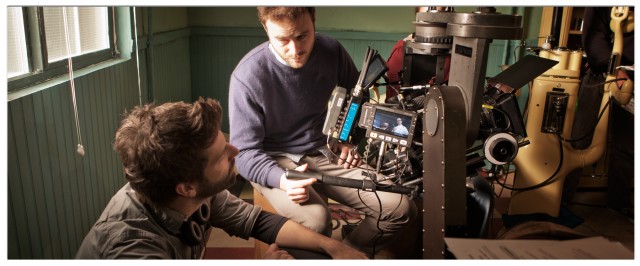
The post process was another beast entirely. Unfortunately we weren’t able to pay our post people, so we were forced to work around their schedules and that’s always difficult. It took nearly eight months to get a final picture lock on the project, which was probably the hardest part.
All in, it took a little over a year from conception to completion and while an extended process like that certainly takes its toll on everyone involved, it’s the only way we could have accomplished what we did with a budget just under $8,000.
Can you tell us, in general, about the life of independent filmmaker trying to “make-it” in LA? How do you differentiate yourself from the crowd of people who have the same dream as you?
I’m usually so consumed by the stories I’m trying to tell level that I spend very little time thinking about “making it” or standing out from the crowd. That could ultimately be to my detriment but it’s the only way I know how to survive. If I were to stop long enough to rationally process the odds of success in an industry as competitive as this one, I’m not sure I would recover.
My strategy has always been to stay positive, to work as hard as I can and to be nice to the people around me. I’m not sure if that’s the best advice in the world, but it feels right to me.
Tell us how festival screenings benefited you? Any tips for our audience in regards to a short horror short on the circuit.
Making a film can be an epic process and if you manage to make it through alive, you deserve recognition. That’s what film festivals provide. A place where all the hard work finally amounts to something tangible. You are treated like gold, you will meet some of the coolest people in the world, and you get to screen your film for a real live audience. There’s nothing like it.
I think it’s a common misconception that you will screen your film in a festival and be discovered. If you’re counting on this, odds are you will be disappointed. Instead, look at festivals as a place to celebrate your work and meet other filmmakers. These are the people in the trenches with you and these are the people who will help you, as you grow together.
Having a film screen at a film festival is an amazing experience, but if you really want to get your film out there, you have to put it online. If you’re lucky enough to get featured on Short Of The Week, even better!
A bit of a broad questions, but what’s the biggest thing you learned while making Root?
Don’t underestimate the importance of post-production and the people who finish your movie. There’s a romance to working on set, with a team of passionate people to make something special. You know what’s not romantic? Sitting in front of a computer screen, for months, all by yourself. Your editor, composer, sound designer, and visual effects artists are the brave souls who will ultimately make or break your movie so be sure to give them the attention, respect and budget they deserve.
What’s your favorite thing about the short format in general? What are some of your favorite short films?
I absolutely love short films, both as a fan and a creator. There’s a common misconception that short films are only stepping-stones to bigger and better things but I couldn’t disagree more. Making a great short is an art form all on its own, and those who can do it well should be celebrated. If a feature film is a fancy cocktail, a short film is a shot. It’s lean, mean and gets the job done. A good short film is storytelling in its purest form.
I do think there are a few things to keep in mind if you’re thinking of making a short of your own.
The script is everything. Without a great script, you’re dead before you even start. Write and rewrite it until it’s great. I know this sounds cliché, but making a short film takes everything you have, your money, your wits and your sanity. If you’re going into battle, make sure you have the ammunition you need.
Swing for the fences. Anyone and everyone can make a short film these days, but if you want people to stop and take notice, you need to stand out from the pack. I’m not suggesting crazy stunts or gimmicks, but find what it is that makes you unique as a storyteller and put that into every frame. Go big or go home. (Disclaimer: most of my opinions on filmmaking I got from “No Fear” t-shirts.)
Go the extra mile. Making a film can be a brutally long process and it’s normal to want to get it out there as soon as possible, but don’t rush it. Spend a little extra time on the credit sequence. Scan for sloppy edits that you may have overlooked. Spend an extra day on the sound design. It may seem nit-picky, but it’s these little improvements throughout that will add up and ultimately take your film to the next level. It’s easy to say, “it’s good enough” but real filmmakers always go the extra mile to make it great.
Finally, tell us about what’s next…what’s the Mortuary Collection and when/how can we see it?
Talk about an unhealthy obsession for short filmmaking, The Mortuary Collection is a feature anthology film that’s composed of five short horror films, all intertwined in a sleepy New England town where nothing is as it seems. If Pulp Fiction and Tales From The Crypt had a baby, and that baby grew horns, developed a case of rabies and was poked with a stick 24-hours a day for seven years, it would start to resemble The Mortuary Collection.
We just finished production on the first segment of the feature, a twisted short film called The Babysitter Murders, which just premiered at The Stanley Film Festival where it won both the Audience and the Jury Awards for best short film. With a little luck, we will raise the additional financing we need to finish the full feature film by the end of the year.
If you want to know more about The Mortuary Collection, or you just want to say hello, drop by our website www.TrapdoorPictures.com or find me on any of the usual social media platforms.
 Ivan Kander
Ivan Kander